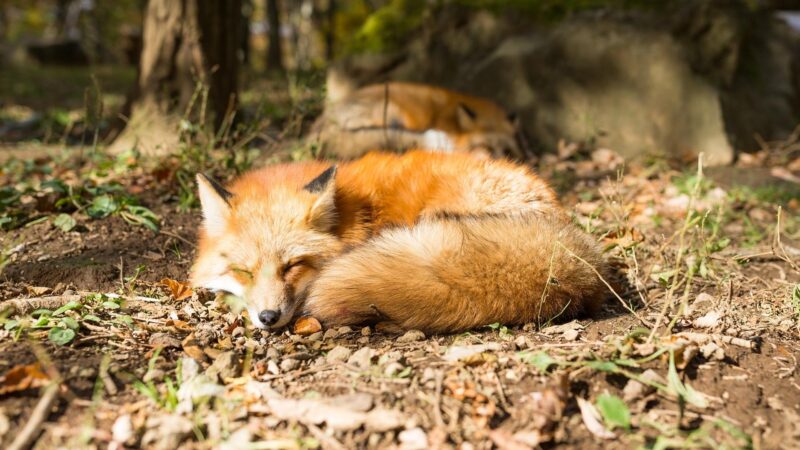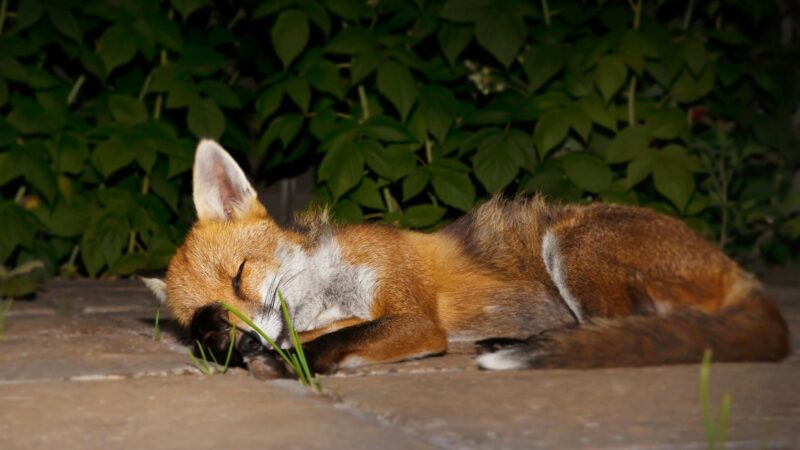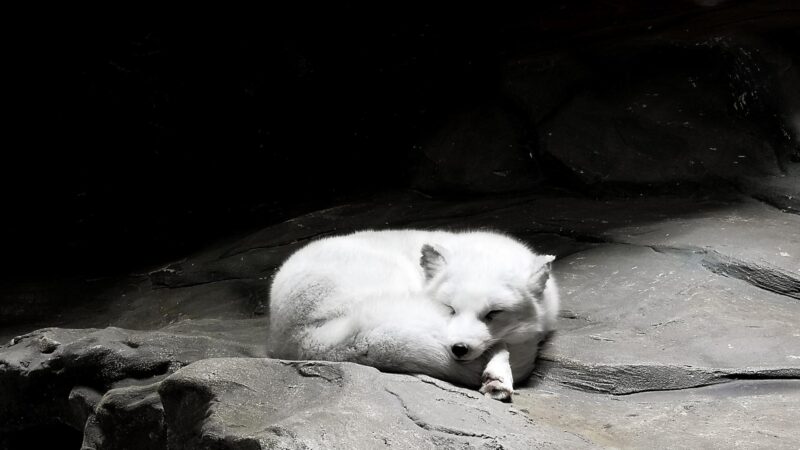You may see foxes during the day but they are mostly active at night. They’re nocturnal so they generally hunt for food at night.
Hence, they sleep during the day. Aside from the time when the foxes are active, their sleeping habits can be interesting too.
Where do foxes sleep? Foxes sleep on the ground when they’re on their own. Urban foxes can be found snoozing under a house, in the garden, or on a deserted lot. But when they have pups to take care of, a den is an essential shelter for sleep and safety. A female fox can dig a den for herself and her offspring. But she can take over the ones made by badgers, rabbits, or other animals.
Various fox species don’t share the same sleeping areas as they’re in different areas. For example, gray foxes dwell in swampy lands, rugged and mountainous terrain, and brushy areas.
On the other hand, red foxes inhabit rolling farms with streams, wooded tracts, and marshes. With several places foxes can occupy, there is also more information about where and how they sleep.
Table of Contents
Fox Sleeping Habits

When the fox is all by itself, it prefers sleeping on the ground or in an open area. In this setting, a fox curls into a ball so its tail covers and warms its body. But a mother with babies needs to seek a den.
You’ll find gray foxes and red foxes unique as they sometimes sleep on trees. They use their retractable claws to climb trees.
Fox Sleeping Behaviors

Foxes can sleep more than 8 hours a day. It’s even 10 hours for an average red fox. Since they’re nocturnal, they won’t be up until sunset. Nevertheless, each fox species has a different sleeping pattern.
Some of them are awakened by sounds made by other animals that intrude into their dens or humans.
These animals are solitary so it’s hard for them to sleep in urban areas where there are constant noises in the surrounding.
Therefore, urban foxes will find an ideal place for sleeping and no one or nothing can disturb them.
Do Foxes Sleep at Night?
Since foxes are nocturnal, they don’t sleep at night. Instead, they look for food and this activity may continue until daytime.
Foxes with kits do it as they need to stock more food. It usually happens from late April until May.
Where Do Foxes Sleep During the Day?
Foxes sleep in a convenient, sheltered site or forested area.
Do Foxes Sleep Underground?
Foxes sleep underground which is their den. They may dig a den or use the one that other animals make.
If it’s the latter, they need to do extensive alterations which can result in a tunnel with two or more openings or entrances that are 8 to 15 inches wide.
Foxes can make a tunnel that is 25 ft to 75 ft long. It can be as deep as 3 ft to 4 ft. The entrances and the open areas of a fox’s den have mounds of soil. Young foxes can be seen playing in these sections.
Piles of feces, urine, and prey remains can be found in the den too. It’s better for foxes with young to sleep in a den when the weather is wet.
Where and When Do Urban Foxes Sleep?

Urban foxes sleep near humans. They can be in the garden, under your house, or abandoned area. Foxes as nocturnal don’t change even though they live in an urbanized area. But their sleep might be disturbed during the day because of all the city noises.
Where and When Do Fennec Foxes Sleep?

Fennec foxes sleep in a burrow that they dig. They sleep in underground dens to protect themselves from the desert heat.
Rearing their offspring also takes place in these dens. There are extensive tunnel systems with several entrances.
These foxes would dig burrows under desert bushes as plant roots support the tunnel walls. Some dens are shared by different fennec fox families. As nocturnal hunters, fennec foxes sleep during the day.
Where and When Do Red Foxes Sleep?

Red foxes sleep on thick cover found on a hilltop and wooded ridge. They prefer to sleep on the ground if they’re alone.
However, they sleep in dens during wet weather and when they have offspring. These dens are found on knolls with loose soil and good drainage, ridges, and slopes.
Red foxes are active all year round and they hunt for food at night or twilight and even during daytime. So, it’s safe to say that they either sleep during the day or at night.
Where and When Do Arctic Foxes Sleep?

Arctic foxes sleep in dens built on hollow mounds of a cliff base, stumpy knolls, and between rocky outcrops. These places are located 3 to 15 feet over the tundra. A den of an arctic fox can be 300 square feet wide with 4 to 8 entrances.
The set-up of a den is like an igloo as it’s underground while the snow above provides insulation. When inside a den, the sleeping distance changes when the arctic foxes that have the highest rank of males and females are in heat.
Normally, there’s a gap of 200 to 250 cm between them. The mating pair gets closer to each other with only 50 cm apart when sleeping as stated in a study.
Since arctic foxes are nocturnal burrowers, they sleep during the day although there are sometimes no day and night in the arctic.
The darkness and midnight don’t only last for a day but a week or even months. Generally, they’re busy searching and digging for food at night.
There can be chances that they get half of sleep in the day and another half at night. They learn to adapt to their surroundings so they can hunt for food at any time whether it’s dark or not.
How Much Do Foxes Sleep?
Most foxes sleep for 7 to 8 hours or more like humans. Some can sleep more. But the hours become shorter when they’re disturbed by noises or intruders.
Frequently Asked Questions
Where Do Foxes Sleep in London?
Foxes have been in Europe since the Ice Age. Thus, it’s no wonder that their population is rampant on the continent. Many urban foxes can be found in London and their population significantly grew in the 1930s.
Hence, foxes can be seen sleeping under houses, wooded lots, hedges, and gardens in London. A Londoner even saw one fox that was peacefully sleeping on the outside sofa. But they generally sleep in areas where they won’t be easily seen as they value privacy.
The population of foxes in London has reached its limit. They become comfortable around residences as some people feed them.
A fox sometimes doesn’t finish its food and it tends to cache the food given by humans in a garden where they can sleep. So, it causes problems for the owner of the garden.
Nonetheless, the average lifespan of foxes in London is 2 years due to the fatality caused by car accidents. It covers 60% of the fox’s deaths.
Are Foxes Lazy?
Foxes are lazy as they’re inclined to scavenge food. It’s the reason why they’re drawn to cities where there’s a good supply of food. As mentioned, receiving food from people tolerates their indolence.
Why Do Foxes Sleep in the Garden?
Just like dogs, foxes are playful and inquisitive. When the cubs begin to be independent, they venture outside of their dens and find their ways to your garden. Hedges and fences can give them a hiding place where they can sleep and remain unseen.
Foxes will sleep in your garden as they like the area filled with things that they find interesting. So, don’t leave objects like balls, gardening gloves and shoes, something made of leather, and clothes hanging on the washing line. When they like your garden, they will mark the area with their feces which is annoying.
Summary
Various fox species are found in different areas and regions. They don’t only vary in appearance but in their sleeping habits as well. As nocturnal beings, most of them sleep during the day.
It’s more common for them to look for food from dusk until dawn. They need to extend the time when looking for food so they do it until the daytime. More food supply is needed when they have offspring to feed.
List of Sources
Foxes. (2021). Pennsylvania Game Commission.
Red Fox. BC Forestry Outreach Center.
Saunders, D. A. (1988). Red Fox. State University of New York, College of Environmental Science and Forestry.
Adams, R. (2004). Vulpes zerda. Animal Diversity Web.
Living with urban foxes. Hastings Museum and Art Gallery.
